

Science Is All Around Us, Let’s Start Popularizing It
Popularize Science and Technology, Improve Citizen Quality, and Build a Harmonious Society
From the bulky CRT monitors and plasma TVs to the emerging laser TVs, the family of display technologies is quite extensive. Many of these display technologies have gradually been replaced over time, but one member that has been “shining” since the 1980s is the Liquid Crystal Display (LCD).

In the 1990s, CRT monitors were prevalent; they were heavy and bulky, and many people have a strong impression of them, but they have long been replaced by more lightweight LCDs.
(Image Source: Wikipedia)
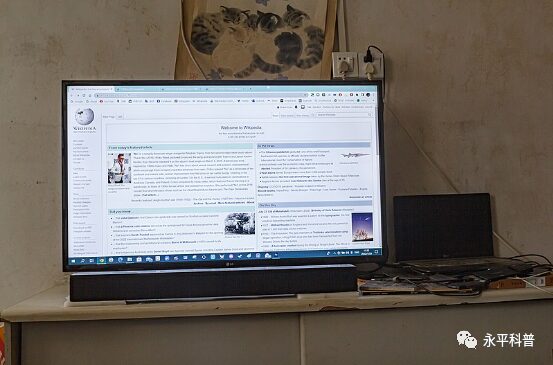
After replacing CRT monitors, LCDs have been widely used.
(Image Source: Wikipedia)
They appeared around the same time as plasma TVs but are clearly more well-known and widely used. So, what technology underlies these affordable and user-friendly LCDs, and what are their characteristics?
Combining Solid and Liquid Properties—The Unique Structure of Liquid Crystals
LCDs are very common in our lives, found in televisions, computers, and various small appliances. To understand LCDs, we first need to know what “liquid crystal” material is. The name itself indicates its characteristics: “liquid” refers to the liquid state, and “crystal” refers to a solid state—meaning that liquid crystals possess properties of both solids and liquids.
We know that water has three states: solid (ice), liquid (water), and gas (steam), and most substances exhibit these three states. Liquid substances are isotropic in terms of molecular distribution, meaning their physical properties are consistent in all directions, resulting from random molecular motion. Solids are crystalline, with anisotropic molecular distribution, meaning different arrangements in different directions. This leads to variations in properties such as refractive index, polarization, thermal conductivity, and electrical conductivity in different directions.

Crystal (left), Liquid Crystal (middle), and Liquid (right) molecular structures.
(Image Source: Rajak P, Nath L K, Bhuyan B. Liquid crystals: an approach in drug delivery[J]. Indian Journal of Pharmaceutical Sciences, 2019, 81(1): 11-21.)
In the past, it was believed that solid and liquid states were distinctly separate, but in 1888, botanist Friedrich Reinitzer extracted a compound called cholesteryl benzoate from plants, breaking this notion. It has two different melting points and, in a molten state or when dissolved in a solvent, loses the rigidity of a solid, forming an intermediate state with properties of both crystals and liquids. Due to the unique state of such substances, they were named “Liquid Crystals.” Liquid crystals can be categorized into three types based on their anisotropic arrangement: nematic, smectic, and cholesteric.
Nematic liquid crystal molecules are elongated and can flow under external forces, so the long axis of nematic liquid crystal molecules generally aligns with the flow direction, meaning they are approximately oriented in the same direction and can pass through each other.
In smectic phases, liquid crystal molecules are layered. The long axes of molecules within a layer are parallel to each other and perpendicular to the layer surface. However, the positions of molecules are not ordered, resulting in a state called positional disorder with orientational order. Smectic liquid crystal molecules can only move within their layer, while layers can slide past each other.
Cholesteric liquid crystal molecules are also layered, with each layer having orientational order. However, overall, the layers are stacked in a helical pattern, with each layer rotated at a slight angle relative to the layers above and below.
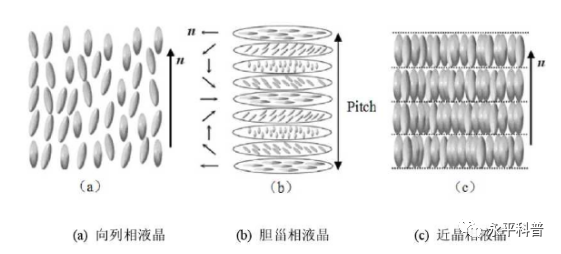
Types of liquid crystal arrangements: nematic, smectic, and cholesteric.
(Image Source: Zheng Guili. Research on the flexoelectric effect and flexoelectric coefficient of nematic liquid crystals[D]. Changchun Institute of Optics, Fine Mechanics and Physics, Chinese Academy of Sciences, 2017.)
Structure Determines Properties—Various Effects of Liquid Crystals
The unique ordered arrangement of liquid crystal molecules gives rise to different properties, such as twisted nematic effect (TN).
Nematic liquid crystal material is sandwiched between two glass substrates, much like a sandwich. The glass surfaces have very fine parallel grooves, known as alignment films. The liquid crystals near the upper glass align according to the direction of the grooves on the upper alignment film, while those near the lower glass align according to the grooves on the lower alignment film. If the two grooves are crossed, the liquid crystals between the two glass substrates will be uniformly twisted. From a top view, the upper layer of liquid crystal molecules is arranged horizontally, while the lower layer is arranged vertically, creating a uniform twist like a spiral that affects the polarization direction of light.
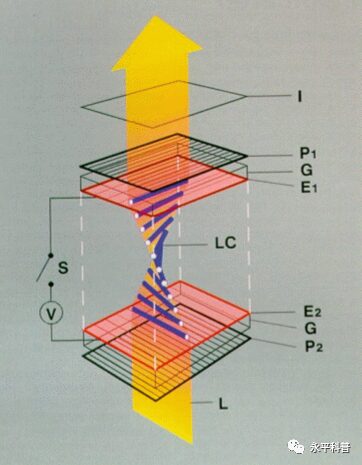
Illustration of the twisted nematic effect.
(Image Source: Wikipedia)
So, what is polarization? We know that light is a type of electromagnetic wave, and waves can be categorized into two types: transverse waves and longitudinal waves. If one end of a rope is fixed and the other end is pulled horizontally while vibrating it up and down, the motion of the rope is a transverse wave. The characteristic of transverse waves is that the direction of particle vibration is perpendicular to the direction of wave propagation; electromagnetic waves are typical transverse waves. In contrast, the direction of particle vibration in longitudinal waves is parallel to the direction of propagation, with seismic waves being an example of longitudinal waves.
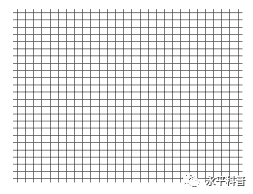
Illustration of transverse waves; the water waves we usually see are transverse waves that oscillate up and down, but the direction of wave propagation is perpendicular to the up-and-down motion.
(Image Source: Wikipedia)
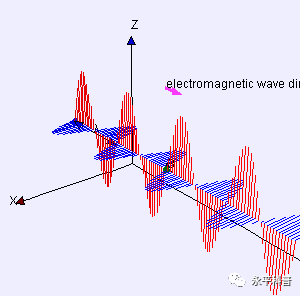
Illustration of longitudinal waves, also known as density waves, where the direction of propagation aligns with the direction of vibration, and the wave propagates through variations in density.
(Image Source: Wikipedia)
Light waves are transverse waves composed of mutually perpendicular electric (z-direction) and magnetic (x-direction) fields, with the vibration direction of light always within the x-z plane, perpendicular to the direction of light propagation (y-direction).
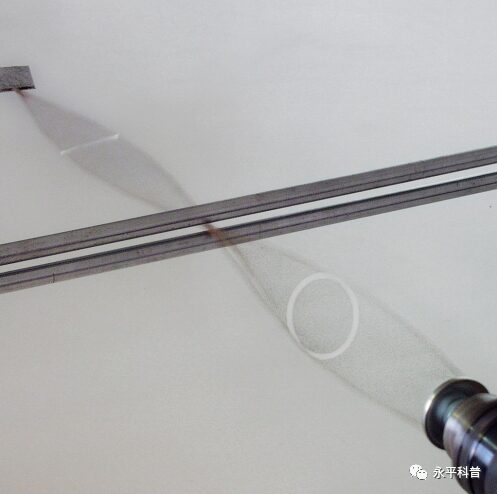
Illustration of light wave propagation, where E represents the electric field and B represents the magnetic field.
(Image Source: Wikipedia)
These two different directional vibration vectors overlap, and from the x-z plane, it appears as if a particle is moving in a regular manner. Depending on the amplitude and phase of the vibration, its motion can be circular, elliptical, or linear, referred to as circularly polarized light, elliptically polarized light, and linearly polarized light, respectively.
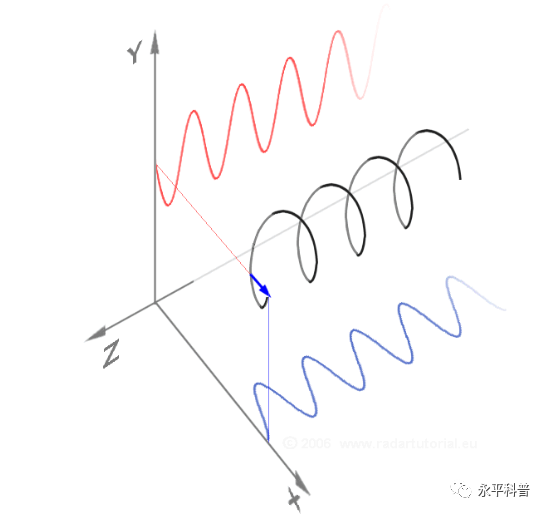
Illustration of circular polarization, where red and blue represent two different directional vibrations, and black indicates the actual motion state of the particle.
(Image Source: Wikipedia)
If we place a slit, due to the directional vibration of light waves, it will be limited by the slit. If the slit direction aligns with the vibration direction, the wave can pass through smoothly. If the slit direction is perpendicular to the vibration direction, the wave will be blocked and cannot propagate. If the slit direction and vibration direction are at an angle, the wave can pass through the slit, but the light intensity will be weakened. This asymmetry between vibration direction and propagation direction is called the polarization of light waves, and the slit serves as the principle of a polarizer.
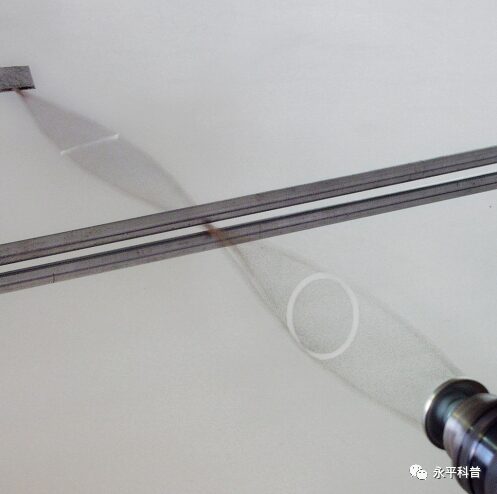
Illustration of polarization, where the right side shows circular polarization, and after passing through the middle slit, the vibration direction aligns with the slit.
(Image Source: Wikipedia)
The twisted nematic effect utilizes the property of polarized light to change the polarization angle of incident light through twisted liquid crystal molecules. So, how is this effect applied in LCDs to create images?
In LCDs, there are originally two polarizers. These two films can only allow polarized light at a fixed angle to pass through. When we arrange these two films at 90°, no light can pass through. However, due to the presence of the twisted liquid crystal layer, light from the upper polarizer penetrates, and after passing through the twisted arrangement of liquid crystal molecules, it is rotated 90°, allowing it to pass through the lower polarizer, forming a complete pathway for propagation.
As voltage is gradually applied to the liquid crystal layer, the liquid crystal molecules will gradually align vertically with the increasing voltage, and the light passing through will gradually weaken. When the voltage reaches its maximum, the liquid crystal molecules become vertical, and no light can pass through the lower polarizer.
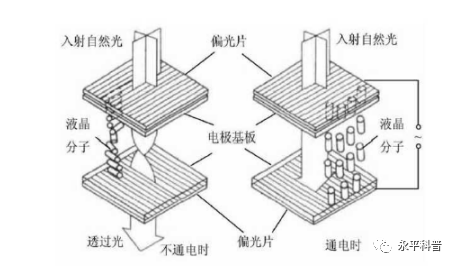
Diagram of TN display technology.
(Image Source: Fang Zeguo. Research on in-plane switching (IPS) thin-film transistor (TFT) liquid crystal materials[D]. Beijing University of Chemical Technology, 2015.)
Having understood how the liquid crystal layer transmits light, let’s look at its imaging process. The liquid crystal layer actually contains very small cell structures, with each one or more cell forming a pixel on the screen. By controlling the light intensity of different pixels through circuits, monochrome images are formed.
Color LCDs operate on the same principle as monochrome displays, except that each pixel consists of three liquid crystal cells, each with red, green, and blue filters in front. Light is processed through the filters, utilizing spatial color mixing to create rich colors.
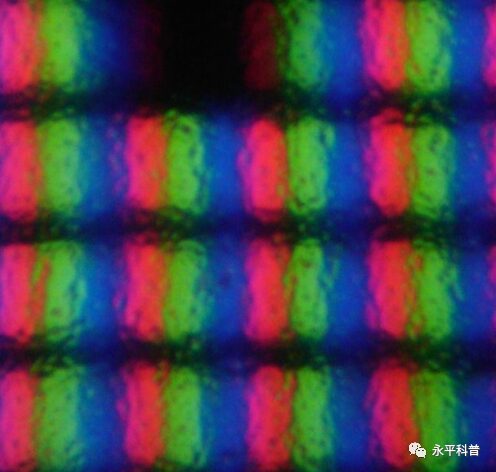
Microscopic structure of TN LCDs, where each pixel is composed of red, green, and blue cells.
(Image Source: Wikipedia)
This liquid crystal screen based on the twisted nematic effect (TN) is what we refer to as TN screens, which are also a classic technology in LCDs. Its advantage is a short response time, but it also has disadvantages. TN screens have low contrast, poor color reproduction, and a narrow viewing angle; users can only achieve the best viewing experience when facing the screen directly. Due to the inadequate user experience provided by TN screens, they are gradually exiting the mainstream market.
People have optimized TN screens based on different liquid crystal arrangements, inventing VA screens (Vertical Alignment) and IPS screens (In-Plane Switching).
VA screens do not utilize the twisted nematic effect to present liquid crystals in a spiral; instead, they align all liquid crystal molecules vertically.
Initially, liquid crystal molecules are arranged perpendicular to the upper and lower substrates, with mutually orthogonal polarizers attached to both sides of the liquid crystal cell. Without voltage, the linearly polarized light passing through the lower polarizer is parallel to the long axis of the liquid crystal molecules, and the polarization state does not change, preventing it from passing through the upper polarizer, resulting in a dark state. When voltage is applied, the liquid crystal molecules rotate under the influence of the electric field, eventually aligning along the direction perpendicular to the electric field, causing the linearly polarized light passing through the lower polarizer to experience phase delay, changing the polarization state of light until the polarization direction of the linearly polarized light rotates 90° within the liquid crystal layer, at which point the polarization direction is parallel to the light transmission axis of the upper polarizer, resulting in a bright state.
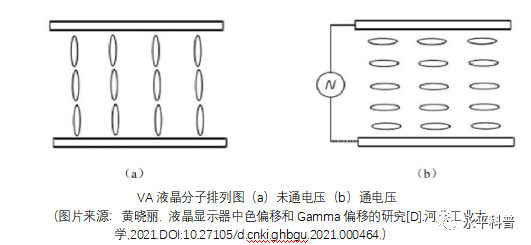
Because the liquid crystal molecules in VA screens are arranged vertically, they can experience significant deformation under external forces, creating patterns similar to water ripples, hence they are also called soft screens. VA screens have a larger viewing angle compared to TN screens, but their larger rotation angle leads to longer response times, resulting in serious ghosting effects.
The principle of IPS display technology is illustrated below, where electrodes are distributed on one side of the lower substrate, and the liquid crystal molecules are arranged parallel to the substrate, forming a specific angle with the electrode direction. Mutually orthogonal polarizers are attached to both sides of the liquid crystal cell, with the lower substrate’s polarizer aligned with the liquid crystal molecules. Without voltage, the linearly polarized light passing through the lower polarizer is parallel to the long axis of the liquid crystal molecules, and the polarization state does not change, preventing it from passing through the upper polarizer, resulting in a dark state. When voltage is applied, the liquid crystal molecules rotate in-plane under the electric field, and the long axis of the liquid crystal molecules becomes orthogonal to the polarization direction of the linearly polarized light passing through the lower polarizer, resulting in a birefringence phenomenon, changing the polarization state of the light until the polarization direction of the linearly polarized light rotates 90° within the liquid crystal layer, at which point the polarization direction is parallel to the light transmission direction of the upper polarizer, resulting in a bright state.
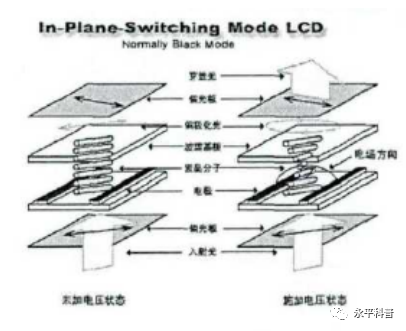
Diagram of IPS imaging principle.
(Image Source: Li Zhifu. Research on Wide Viewing Angle Technology of TFT-LCD[D]. Fudan University, 2011.)
Compared to VA screens, the arrangement of liquid crystal molecules in IPS screens is horizontal, allowing them to withstand greater pressure without affecting image formation, thus IPS screens are also referred to as hard screens.
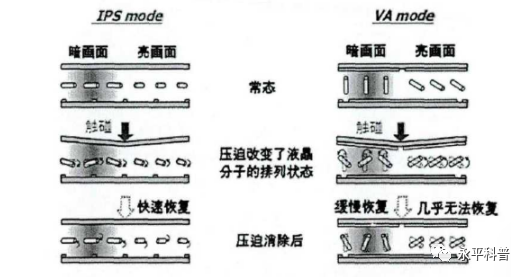
State of liquid crystal molecules in IPS and VA under pressure.
(Image Source: Li Zhifu. Research on Wide Viewing Angle Technology of TFT-LCD[D]. Fudan University, 2011.)
Because the liquid crystal molecules in IPS technology rotate in a plane parallel to the substrate during the transition from dark to bright states, the display effect remains similar from various angles of observation. Therefore, IPS screens can resolve the limited viewing angles of TN screens, providing a wider viewing angle for users.
Cannot Self-Illuminate—The Light Source of LCDs
You may have noticed a problem: where does the light source for liquid crystals come from? Indeed, liquid crystals are not self-luminous displays; they require an external light source to emit light.
The light sources for LCDs mainly come in two forms: one is fluorescent lamps, similar to those used for classroom lighting, which are primarily distributed on the sides or bottom of the display. The other is the currently widely used light-emitting diode (LED) light source, which is what we refer to as LED LCDs. Because LEDs are very small, using them as a light source allows for thinner displays.
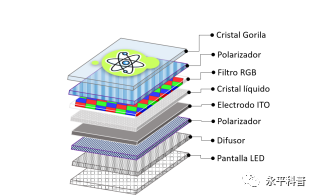
Structure of LED screens (from bottom to top: LED backlight layer, scattering plate, polarizer, ITO substrate, liquid crystal layer, RGB filter, polarizer, glass layer).
(Image Source: Wikipedia)
Conclusion
In fact, LED-based LCDs are not perfect; their color representation capabilities are not particularly outstanding. However, due to their relatively low prices and lower modulation voltages, they have remained active in our lives since their inception in the 1980s. It can be said that LCDs are indeed the evergreen trees of the display family!
Reformatted and edited by Science China
Content from: China Science Popularization Exhibition





